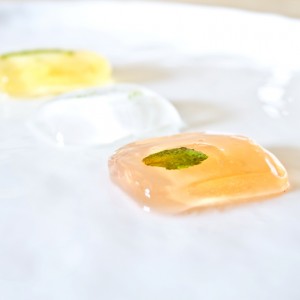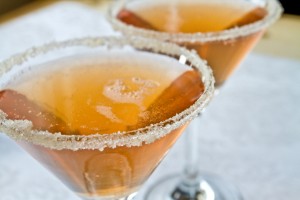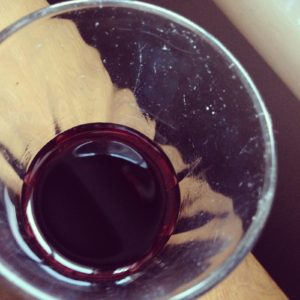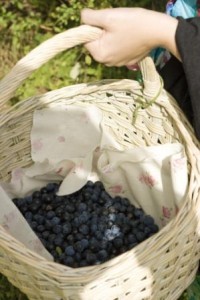I love cheesecake. This recipe for mini cheesecake mess is a great way of using up almost anything sweet you’ve got hanging around and, if I do say so myself, look pretty cute too. A lovely little sweet treat for lunch or after dinner. Have you ever tried to make cheesecake (or cream cheese icing) with low fat soft cheese? It never seems to work for me and just ends up all runny and no good at all. I thought I’d give it a try with some Laughing Cow Extra Light to see if that would work, and use up some leftover festive food in the cupboards, and I was so pleased with how they turned out!
Slojito
I have been so busy this year that I have run out of time to make my own sloe gin. It’s not the end of the world though as I have some of last year’s stash left and once that’s gone there are some delicious ready steeped and drained sloe gins around. As much as I enjoy a classic sloe gin and tonic there’s much enjoyment to be had mixing up something different.
One place you can find some inspiration for new drinks to try is thebar. I found their recipe for a slojito and just had to give it a try!
Stilton Scones with Sloe Port Jelly
Ingredients
You will need (for 10-12 scones):
240g self raising flour
Pinch of salt
Black pepper
50g butter
60g Stilton
130ml milk plus extra for brushing
For the sloe port jelly:
100ml sloe port (any other port would be good too)
60ml water
30g sugar
2 sheets gelatine
Method
Make the jelly first.
Put the gelatine into some cold water to soften.
Get a small saucepan on a low heat and add the sugar and water. Once the sugar has dissolved squeeze out any excess water from the gelatine and stir the gelatine into the hot sugar syrup.
Gin and Tonic Mini Jellies
Ingredients
You will need (for around 12 mini jellies):- 30g sugar
- 50ml water
- 120ml pre-mixed gin and tonic
- 3 sheets gelatine
- Decorations of your choice (e.g. herbs or zests)
You may have noticed that I have three different coloured jellies. Indeed, not only was this an excuse to get out my calculator and work out gin to tonic to gelatine proportions but also a good reason to try out my new jelly mould and gins. The proportions above are for 12 jellies in total of around 10g each; feel free to mix up whatever spirits you have just divide the total gin and tonic amount by the amount of flavours you want to try and make different batches.
Method
Best to get the mathematics out of the way before you start your jelly making just in case you feel the need to make and drink a G&T at the same time. Not that I did of course. First of all put your decorations of choice into the jelly mould and go about selecting your gin. I went for: Sloe Gin and Mint, Saffron Gin and Cucumber and Gin and Lime Zest.Put the sugar and water into a pan to dissolve the sugar and then bring to the boil. While the sugar and water are heating put the gelatine into cold water. Once the sugar syrup has boiled remove from the heat, squeeze the excess water from the gelatine and stir the gelatine into the syrup until dissolved. Pour in the pre-mixed gin and tonic and stir gently so that you retain some of the fizz. Pour the jelly mix into your jelly mould and refrigerate until set. I like knowing that if you dissolve five sheets of gelatine into 500ml of liquid it will set to a decent quiver so I upped my gelatine to liquid ratio to make these thicker and more like adult gummy bears.
Sloe Gin and Tonic with Elderflower and Apple
Ingredients
You will need (per glass):
- 50ml sloe gin (to make your own see recipe here)
- 1/2 cap full Mr Fitzpatricks Elderflower and Bramley Apple Cordial
- Tonic
- Juice 1 lime
- Caster sugar
Method
I was going the whole hog with this one, sugar crusting on the edge and everything. It’s easier to make the cocktail in another receptacle and then pour it into the sugar encrusted glass; much less risk of dribbling and dissolving. Start by squeezing the lime juice onto a small plate and putting a thin layer of caster sugar on another plate. Dip the rim of each glass into the lime juice and then into the sugar so you form a rather pretty (sweet and sour) edge to the glass. Mix together the sloe gin, cordial and tonic in a jug and then pour into the prepared glasses.
Leftover Sloe Chocolate Truffles
You will need:
A large handful port soaked sloes, de-stoned (recipe for making sloe port here)
150g dark chocolate
150ml double cream
25g butter
Cocoa Powder
Heat the cream up gently until almost boiling, stirring often so it doesn’t catch.
While the cream heats up, grate the chocolate into a bowl, cut the butter up and put this in the bowl too. To be honest I did this before I heated the cream otherwise I knew the cream wouldn’t get the attention it deserved and I’d still be cleaning the kitchen now.
Sloe Port: The Taste Test
My Sloe Journey
Gin – first of all the sloes were steeped in gin. This particular batch included some blackberries which have to be removed after three months to stop them turning bitter. At this point I had a litre of glorious hedgerow gin and some plump, gin filled sloes that couldn’t be simply thrown away. Port – the berries leftover for the gin weren’t going to be wasted so they were made into sloe port. Chocolate – once the port is finished the berries will be used again to make some sloe chocolate truffles.So now I have a Rumtopf full of sloes swimming in ruby red port. The port is fantastic; a more rounded version of the sloe gin. You get the flavour of sloes, the warmth of the alcohol and the richness of red wine. There’s nothing else quite like it. I can’t wait to have some with cheese, add it to gravy for richness and put a little in a hip flask for a calm evening walk. My sloes and I have been on a magnificent adventure thus far but where can I go from here? I have a few ideas up my sleeve to ensure that the sloes are used to their full potential. Out of 2kg of sloes I have produced 3l of elixir and I don’t intend to stop there.
Sloe Port – how to use leftover sloes
Top Tips
First and foremost separate the gin from the berries. Not as easy as it sounds; one kilo of sloe berries fills a much larger space than the average sieve provides. I would recommend the bath rather than the kitchen sink to help stop any escaping berries and gin. Once this task has successfully been completed, make the sloe port. When making my sloe gin I ignored the advice to use cheap gin. I’ve tried sloe gin using cheap gin and nicer gin and it does seem to make a difference. I applied the same rule to the port; I used wine I would have been happy to drink.Variations
Sloe port is a brilliant way to use up leftover sloe berries and makes something a little different. If you want to use the sloe berries another way, you can simply add more gin and sugar and make another batch of sloe gin.
To find out what the sloe port turned out like you can find the taste test here. It also makes a fantastic sloe port jelly to serve with cheese.
After the sloes have been decanted from the port, they can be used again to make some sloe chocolate truffles.
Pin my Sloe Port recipe for later!
Sloe and Hedgerow Gin: The Taste Test
Some of you may know that I made my own sloe gin and hedgerow gin this year. It all started on a warm September afternoon with a kilo of sloes, some hedgerow berries, a sprinkling of sugar and a litre of fine gin. It’s something I’ve never even attempted before but I thought how hard can it be?
Turns out it’s extremely simple. Put it all together and leave the flavours and juices to mingle and infuse for as long as you can wait. The longer you can wait the better as the flavour gets more intense and the colour gets darker.
The verdict
The wait is definitely worth it. I first tasted the batches of sloe and hedgerow gin at only six weeks old and it tastes wonderful already. It’s sweet, syrupy, fruity and sublime. It does also of course have plentiful amounts of alcohol in which can’t fail to warm ones cockles. It’s delectable alone, toned down with tonic and opens a door to a new world of cocktails.
The hedgerow gin is surprisingly different to the sloe gin. The addition of a few rosehips and blackberries gives this gin extra richness and more flavour in the middle. It’s got added fruitiness without being too much.
I left both gins for a few weeks longer and I think they are at their best after around three months. At which point I strained the gin off into a clean, sterilised container and set about making some sloe port. It’s a great way to use the sloe berries again.
I’ve got a few ideas for using your gin (other than drinking it!): mix up a cocktail or make some adult gummy bears.
If this year wasn’t your sloe year (maybe it was your slow year!), it is definitely worth a try next year.
Making Sloe and Hedgerow Gin
Top Tips
I very much advise you wash your sloes before freezing otherwise you might end up with a few (used to be) living hedgerow beings in your finished gin. I’m not sure anybody would appreciate you pouring them a spider.
When you go out to pick your sloes I must warn you that 1kg of sloes is a good couple of hours of work, scratched wrists, attack of the stinging nettles and excellent fun if you take a friend. I’m not making it sound very appealing but what you get at the end of all the work makes it so worthwhile. You can take a look at this handy guide if you’re new to foraging to help you identify the sloes. I also have a few golden nuggets of foraging advice too.








